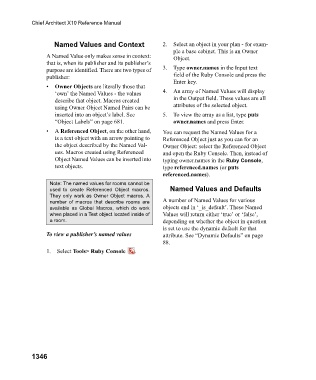Page 1347 - Chief Architect Reference Manual
P. 1347
Chief Architect X10 Reference Manual
Named Values and Context 2. Select an object in your plan - for exam-
ple a base cabinet. This is an Owner
A Named Value only makes sense in context: Object.
that is, when its publisher and its publisher’s
purpose are identified. There are two types of 3. Type owner.names in the Input text
publisher: field of the Ruby Console and press the
Enter key.
• Owner Objects are literally those that
‘own’ the Named Values - the values 4. An array of Named Values will display
describe that object. Macros created in the Output field. These values are all
using Owner Object Named Pairs can be attributes of the selected object.
inserted into an object’s label. See 5. To view the array as a list, type puts
“Object Labels” on page 681. owner.names and press Enter.
• A Referenced Object, on the other hand, You can request the Named Values for a
is a text object with an arrow pointing to Referenced Object just as you can for an
the object described by the Named Val- Owner Object: select the Referenced Object
ues. Macros created using Referenced and open the Ruby Console. Then, instead of
Object Named Values can be inserted into typing owner.names in the Ruby Console,
text objects. type referenced.names (or puts
referenced.names).
Note: The named values for rooms cannot be
used to create Referenced Object macros. Named Values and Defaults
They only work as Owner Object macros. A
number of macros that describe rooms are A number of Named Values for various
available as Global Macros, which do work objects end in ‘_is_default’. These Named
when placed in a Text object located inside of Values will return either ‘true’ or ‘false’,
a room. depending on whether the object in question
is set to use the dynamic default for that
To view a publisher’s named values attribute. See “Dynamic Defaults” on page
88.
1. Select Tools> Ruby Console .
1346

